A RECORD OF
EUROPEAN ARMOUR AND ARMS
THROUGH SEVEN CENTURIES
by
Sir Guy Francis Laking
CHAPTER I
GENERAL HISTORY OF ARMOUR AND ARMS, PRIOR TO THE NORMAN
CONQUEST, A.D. 1000-1070
PART 1: ARMOUR (BYRNIE, HELMET
AND SHIELD) AND ARMS (BOW AND ARROWS, SEAX, AXE, SLING AND SPEAR)
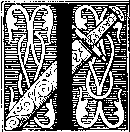 f we were to follow the usual custom employed by
those who have written on the evolution of arms and defensive armour before
us we should take the very earliest records as the foundation of our story,
and the weapons of prehistoric man, his stone axe, his spear-head and arrows
would occupy our attention in the initial chapter. We should follow by relating
all the information obtainable respecting the weapons used throughout the
many centuries that passed between the bronze age and the period preceding
the Christian era, when the armourer's craft reached a very high state of
perfection; and we should not leave unmentioned the beauties of the Etruscan
helmet or of the Greek's crested head-piece, nor omit descriptions of the
many Greek, Roman, and Gallic armaments that the hand of time has spared
to be discovered in such plenty. We shall, however, leave these subjects
behind us, and begin to unravel the skein of our story at a point late in
the history of the world.
f we were to follow the usual custom employed by
those who have written on the evolution of arms and defensive armour before
us we should take the very earliest records as the foundation of our story,
and the weapons of prehistoric man, his stone axe, his spear-head and arrows
would occupy our attention in the initial chapter. We should follow by relating
all the information obtainable respecting the weapons used throughout the
many centuries that passed between the bronze age and the period preceding
the Christian era, when the armourer's craft reached a very high state of
perfection; and we should not leave unmentioned the beauties of the Etruscan
helmet or of the Greek's crested head-piece, nor omit descriptions of the
many Greek, Roman, and Gallic armaments that the hand of time has spared
to be discovered in such plenty. We shall, however, leave these subjects
behind us, and begin to unravel the skein of our story at a point late in
the history of the world.
It would be difficult, almost impossible, to select any one given year
and describe definitely the arms and armour in use at that juncture, and
with these uncertain data to enter upon our story of evolution. We must
take a date - we have chosen the year A.D. 1000 - and there look about us,
making survey of what evolution and necessity have then already taught the
armourer. Thenceforward we may attempt to carry the unbroken history of
the craft.
We begin slowly, halting in the tale. Records of this age are few; already
the writers who deal with arms and armour have made most of them over familiar
to antiquaries. So it is, that with the best will to bring fresh evidence
to the work, we must yet, now and again, show a picture that has become,
even in the school history book, as well known as any postage-[1]stamp.
Thus we produce once more that famous illustration from the Anglo-Saxon
Manuscript of Aelfric's Paraphrase: without it we could not safely begin
our history of the Englishman's war-gear.
As far as may be, we have taken our illustrations from English sources,
to which the reader may go himself for more assurance. Only where English
examples fail have we sought help abroad.
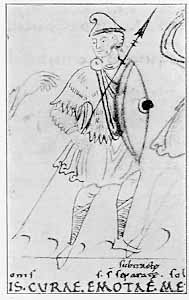 |
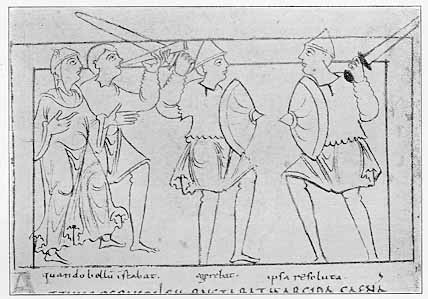 |
| FIG. 1. SHOWING THE PLAIN, ALMOST FLAT SHIELD
Cott. MS. Cleop. C. 8 British Museum |
FIG. 2. SHOWING THE STRONGLY CONVEX AND PROBABLY
SEGMENTED SHIELD Cott. MS. Cleop. C. 8 British
Museum |
In a few words one may make the picture of the Anglo-Saxon warrior of
the fyrd, the man who came light-armed from the greenwood and the plough-gang
to the mustering. He was unarmoured, save for his byrnie or battle-sark,
which doubtless was composed of strips of leather sewn tile-wise to a foundation
of coarse linen, as leather of thickness for defensive purposes, unless
so arranged, would be too stiff a casing for the body. A cap of the Phrygian
fashion, plain leather, or reinforced with copper, occasionally with iron
bands, kept his head. His legs, from the knee downward, were protected by
thongs of leather, wound puttee-wise and meeting a hide shoe cut after the
manner of the Highland brogue of the XVIIth century. A round buckler, either
fashioned flat like the Scottish targe with strengthening bands and boss
of iron, as seen (Fig. 1), or very deeply hollowed, as we see represented
(Fig. 2) (both from Cott. MS. Cleop. C. 8), was his last defensive [2] piece. Of such shields, or as the Anglo-Saxons
called them, bord or board, our English museums can only show
the iron bosses and the fragments of iron rims recovered from graves; but
one, apparently of oak, a fairly complete specimen found in Blair Drummond
Moss, is now preserved in the National Museum of Antiquities at Edinburgh.
Of this we give an illustration (Fig. 3). We are, however, fairly familiar
with the variations of their form from the MSS. that exist. In their manufacture
the foundation was usually of linden or lime-tree wood; in the poem of Beowulf,
Wiglaf seizes his shield of "the yellow linden." They were for
the most part circular; the boss forming the centre. In the illustrations
they are generally shown concave, so as to cover the breast and shoulder
well. The convex surface turned towards the enemy, to turn the blow of a
sword or the thrust of a spear. The wooden foundation was so made as to
leave an aperture for the hand in the centre, and over this came the boss
guarding the hand. Indeed, their method of grip was exactly the same as
the circular bucklers of the early years of the XVIth century. Stretched
over the wood and under the boss and rim and bands was the hide of bear,
wolf or deer, fur outwards; by the law of Æthelstan, and doubtless
by the more ancient laws of tribal lore, it was forbidden to use the skin
of the mild sheep for covering a war-shield.
| FIG. 3. REMAINS OF A WOODEN SHIELD Found
in Blair Drummond Moss |
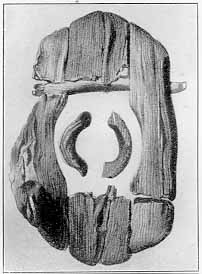 |
Even in the days of peace the Anglo-Saxon carried a spear as his descendants
carry a walking stick; in war his common arms were spear and sword. The
spear in contemporary drawings is crudely represented by a thin straight
line with a leaf-shaped or barbed head; we know that in reality the hafts
were of medium thickness, the length varying according to the requirements
of the wielder. Very many spear-heads of Saxon times have been handed down
to us; in most cases they are simply constructed of iron, fashioned to the
outline of a short sword blade, for the greater part of the length of which
the sharpened edges are almost parallel, although gradually tapering at
the extreme end. In nearly every example the haft socket is forged in the
manner of all later lances and spears, though not completely encircling
the shaft, in fact split as in the illustration (Fig. 4, a, b, c). (Fig.
4, d), is a javelin head, light but very strong; in this case the haft socket
[3] is complete. The lance heads illustrated
are all London finds and are now in the London Museum. In greater variety
the Saxon lance and spear-head are to be seen in the British Museum. The
spear was the freeman's weapon, and as such lawful, but "if a slave
be found with a spear it shall be broken on his back."
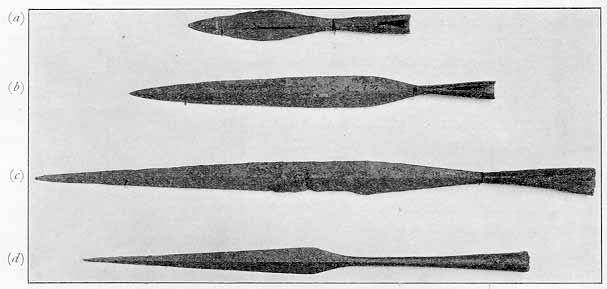 |
FIG. 4. SAXON SPEAR AND LANCE HEADS
(a) Small spear-head, VIIIth to Xth century, split haft socket, found in
the Thames opposite the Tower of London
(b) Spear-head, Xth to XIth century, split haft socket, found in the Thames
at Vauxhall
(c) Long spear-head, decorated, Xth to XIth century, split haft socket,
found in the Thames at Wandsworth
(d) Javelin bead, Xth to XIth century, complete haft socket, found in the
Thames opposite the Tate Gallery
London Museum |
In his barrow grave the freeman lies with his spear beside him. We find
the spear-head near his foot, the ferrule by his head; he was buried with
the "reversed arms" which still are the symbol of warlike grief.
The bow was no national weapon of the Anglo-Saxon; the bowmen were on the
other side at Hastings; it was not until he had learned to bend the mighty
bows of Gwent that the English archer came to his pride of place. Arrow-heads
of this period are rarely discovered. An illustration of an Anglo-Saxon
bow and arrow in use is given from the Utrecht Psalter, early XIth century
(Harleian MS. 603, Brit. Mus.) (Fig. 5), also an illustration of an arrow-head
found in the river Thames at Wallingford (Fig. 6), and an example from the
Thames at London (Fig. 7).
 |
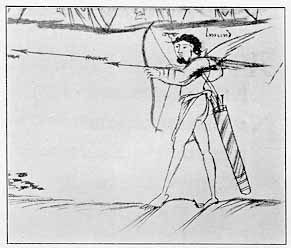 |
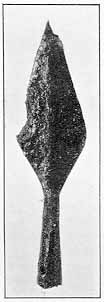 |
| FIG. 6. ANGLO-SAXON ARROW-HEAD Found in the
Thames at Wallingford Collection: Author |
FIG. 5. ANGLO-SAXON BOW AND ARROW From the Utrecht
Psalter, Early XIth century. Harleian MS. 603, British Museum
(page 5) |
FIG. 7. ANGLO- SAXON ARROW- HEAD Found in
the Thames at Southwark London Museum |
We see in the Bayeux needlework the Anglo-Saxon slings. They also figure
in the Cotton MS. Claudius B. 4 (Fig. 8). Knife and dagger seax [4] were likewise auxiliary weapons. These are found
in most Saxon districts. London is responsible for many fine specimens.
The seax is back-edged and in profile not at all unlike the modern
Cingalese dagger (Fig. 9, a and b).
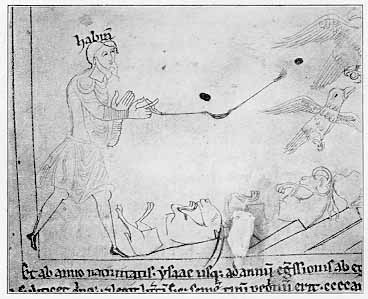 |
FIG. 8. SAXON SLINGER
Cott. MS. Claudius B. iv. British Museum (page
6)
|
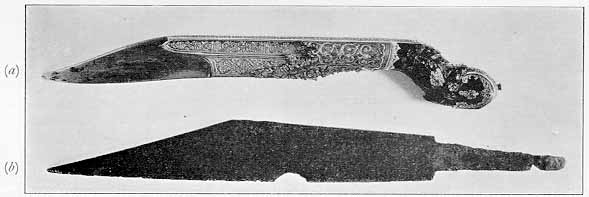 |
FIG. 9. (a) MODERN CINGALESE DAGGER
(b) SAXON SEAX London Museum (page
6) |
We have already said that the simple militiaman of the fyrd fought light-armed
in a leather coat. But the thegn who led him to the field was better fenced
with his byrnie of ringed mail. We may not trust over much to the
Bayeux needlework for the picture of English warriors. Yet it is to be remarked
that it gives the same gear to Norman knight and English house-carle, each
alike wears the ringed hauberk almost to the knee, and the helmet with the
nasal-guard. His poets tell us that the Englishman's ring-byrnie
was "hard hand-locked"; the poem of Beowulf has words of "locked
battle-shirts." Precious were these battle-shirts and not to be bartered
lightly; no merchant, said the law, shall send byrnies over sea.
But here we are confronted by the difficulty with which all students
of the history of armour have to contend; how were the old English mail-shirts
wrought? Was it a garment of leather on which rings of metal were sewn at
regular intervals, in varying degrees of closeness according to the [5] quality of the shirt, or was the hauberk or
ring-byrnie a true shirt of interlinked chain-mail? We incline to
the theory that the Anglo-Saxon hauberk was of chain-mail; for without doubt
true shirts of mail of the Viking type have been discovered both at Vimose
and Thorsberg. Although belonging to a date considerably earlier than the
period of which we now write, it therefore seems probable that, since these
have been found, others no doubt existed in numbers; it is also reasonable
to suppose that if the VIIth and [6] VIIIth
centuries produced in Northern Europe an interlinked shirt of mail, its
superiority over other warlike garments would have caused such mail shirts
to find their way in the course of the next two centuries into the greater
part of civilized Europe. Of the intricacies of "banded" and "regulated"
mail we will speak briefly later on. But for support of the theory that
the ring-byrnie was of simple interlinked chain-mail, with-out the
addition of leather thongs or lining, we may turn to the Bayeux needlework
and point to the dead Englishman, whose hauberk of mail is being dragged
inside out over his head, as live Englishmen pull off their woolen sweaters.
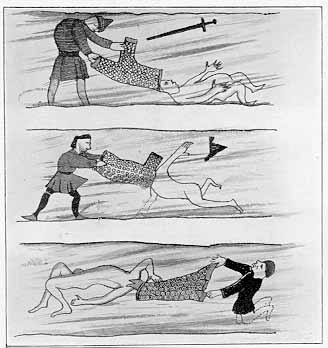 |
FIG. 10. NORMANS DIVESTING SAXON DEAD OF
THEIR HAUBERKS OF MAIL
From the Bayeux needlework |
In this picture the inside of the byrnie is plainly shown, and
it will be noticed that it exhibits what may be taken as small links, and
that it is unlined (Fig. 10).
As for the shield of the English thegn or full-armed warrior it had the
form of that borne by lesser men, although it was possibly made of richer
materials. In the British Museum there are examples of the boss having a
silver disk of about the size of half-a-crown, soldered to a base of bronze,
[7] affixed to the summit, and ornamented with
large silver-headed rivets round the edge.
At Hastings the thegns and house-carles fought round their doomed king,
swinging the long-hafted axe, splitting the bodies of Norman knights and
shearing horse-heads at the neck. This axe was the traditional weapon of
the house-carles; those of Cnut's body-guard bore it. Long after the conquest
of England, when lance and sword were the knightly weapons, the memory of
those great axes was in men's minds. In ancient rolls of blazonry, made
so late as the beginning of the XIVth century, they are painted as charges
upon shields, and still named as haches daneis, the Danish axes.
The old Surrey family whose surname was Huskerley, bore three such axes
in their shield, showing that two or three centuries after the last house-carles
died with Harold and his brothers, there was a dim fancy that an axe of
Danish fashion was the only symbol of one who took his name from some ancestral
house-carle.
The bronze and iron helmets of the English thegns resembled those of
the Norman invaders. No complete specimen is known to the writer; indeed,
our national treasure house, the British Museum, fails us in even an incomplete
example. [A fairly comphehensive discussion of these
helmets, including a recent find, may presently be found at theAngelcyn.site] There was formerly, however, in the collection
of Mr. Thomas [8] Bateman of Derbyshire, the
iron framework of a helmet of Anglo-Saxon times. This framework is now in
the Public Museum, Sheffield (Fig. 11). It was found in the year 1848 in
a low mound, surrounded by a slight rampart of earth, at Benty Grange, near
Monyash, Derbyshire. The iron bands are surmounted by the figure of a boar
standing upon a bronze plate. The bands are partly enriched with inlays
of silver. It has been surmised, and probably correctly, that the lining
of the helmet was of copper or even horn. There is a form of nasal guard
attached.
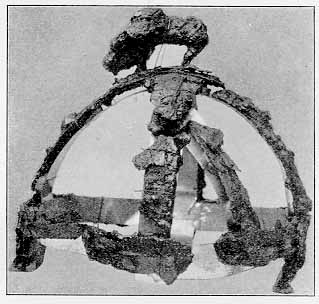 |
FIG. 11. FRAMEWORK OF A HELMET: ANGLO-SAXON
IXTH-XITH CENTURIES
Found at Benty Grange, near Monyash, Derbyshire.
Public Museum, Sheffield (page 8) |
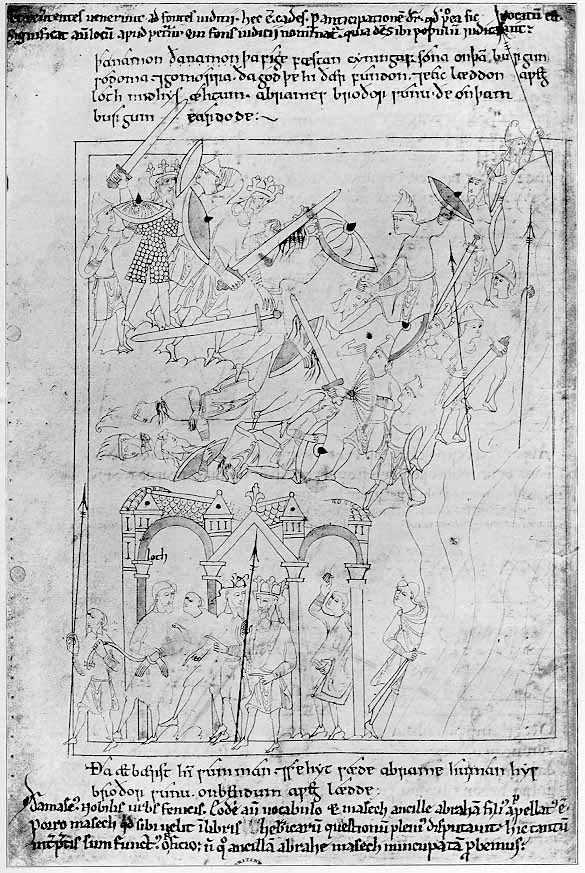 |
Fig;. 12. ÆLFRIC'S PARAPHRASE OF THE PENTATEUCH
Cott. MS. Claudius B. iv. British Museum
The letterpress refers to the group of figures in the top left-hand corner
of the Missal, but the representation of the shields, helmets, and weapons
of the other combatants are all worthy of the closest scrutiny. [full page 9] |
In an illustration (Fig. 12) chosen from Cott. MS. Claudius B. iv, Ælfric's
Paraphrase of the Pentateuch and Joshua, to which we have already referred,
we see in the top left-hand corner the two kings helmetless but each wearing
a crown. The first king is clothed in the loose Saxon gunna caught
up at the waist, and with puckers, characteristic of Saxon fashion, in the
sleeves. Apparently he is without thongs binding his legs. He is armed with
a sword, long and double-edged, but is shieldless. The figure immediately
to his left is his shield-bearer, although his charge is curiously held.
The second king is habited in the ring-byrnie, with loose sleeves
which reach to the elbow, and, as far as can be seen, open at the neck,
descending to just above the knee, and with a short split at the front.
Besides brandishing a sword of similar form to that of the first king, he
holds out in front of him a round, convex shield with a spiked boss in the
middle. The surface of this shield is plain, although that of his shield-bearer
beside him, is represented as being constructed in segments.
The legs of the second king are apparently bare, but he has shoes or
brogues of leather. The representation of the ringed mail is crude in the
extreme, the links are the size of a crown piece, and would certainly appear
to be sewn flat upon a foundation and not linked together.
But in spite of this, when we consider the conventional drawings of this
period, with town walls like hen-coops, rocks and ploughed fields depicted
as cloud-like forms, we can readily assume that a true interlinked chain-mail
hauberk might be indicated in the inaccurate fashion of this illustration.
[...10...]
Return to site home page ~ framed ~ unframed
 f we were to follow the usual custom employed by
those who have written on the evolution of arms and defensive armour before
us we should take the very earliest records as the foundation of our story,
and the weapons of prehistoric man, his stone axe, his spear-head and arrows
would occupy our attention in the initial chapter. We should follow by relating
all the information obtainable respecting the weapons used throughout the
many centuries that passed between the bronze age and the period preceding
the Christian era, when the armourer's craft reached a very high state of
perfection; and we should not leave unmentioned the beauties of the Etruscan
helmet or of the Greek's crested head-piece, nor omit descriptions of the
many Greek, Roman, and Gallic armaments that the hand of time has spared
to be discovered in such plenty. We shall, however, leave these subjects
behind us, and begin to unravel the skein of our story at a point late in
the history of the world.
f we were to follow the usual custom employed by
those who have written on the evolution of arms and defensive armour before
us we should take the very earliest records as the foundation of our story,
and the weapons of prehistoric man, his stone axe, his spear-head and arrows
would occupy our attention in the initial chapter. We should follow by relating
all the information obtainable respecting the weapons used throughout the
many centuries that passed between the bronze age and the period preceding
the Christian era, when the armourer's craft reached a very high state of
perfection; and we should not leave unmentioned the beauties of the Etruscan
helmet or of the Greek's crested head-piece, nor omit descriptions of the
many Greek, Roman, and Gallic armaments that the hand of time has spared
to be discovered in such plenty. We shall, however, leave these subjects
behind us, and begin to unravel the skein of our story at a point late in
the history of the world.










